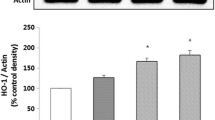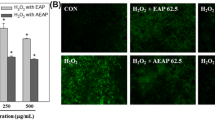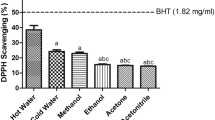Abstract
Purpose
Olive oil contains several phenolic compounds possessing antioxidant activity. The aim of this study was to investigate the protective effects of olive oil phenolic extract (OOPE) and one of its constituents, gallic acid (GA) against H2O2-induced oxidative stress and apoptotic cell death in HeLa cells, a model for human epithelial cells.
Methods
The cells were pretreated with nontoxic doses of OOPE or GA for 4, 24 and 48 h, and the intracellular reactive oxygen species (ROS) level was determined, before and after oxidative stress induction with H2O2. As an indicator of apoptosis, caspase 9 activity was measured.
Results
All pretreatments reduced ROS generation. Four hour incubation with OOPE or GA completely inhibited ROS generation. Increases in caspase 9 activity by OOPE and GA pretreatment under harsh stress conditions were inhibited 92 and 67.8%, respectively.
Conclusions
These results suggest that OOPE and GA act as powerful antioxidants against oxidative stress and exert anti-apoptotic effects.



Similar content being viewed by others
References
Halliwell B (1994) Free radicals and antioxidants: a personal view. Nutr Rev 52:253–265
Ames BN, Shigenaga MK, Hagen TM (1993) Oxidants, antioxidants and the degenerative disease of aging. PNAS USA 90:7915–7922
Bohr VA (2002) Repair of oxidative DNA damage in nuclear and mitochondrial DNA, and some changes with aging in mammalian cells. Free Radical Bio Med 32(9):804–812
Carrasco-Pancorbo A, Cerretani L, Bendini A et al (2005) Evaluation of the antioxidant capacity of individual phenolic compounds in virgin olive oil. J Agric Food Chem 53(23):8918–8925
Visioli F, Galli C (2002) Biological properties of olive oil phytochemicals. Crit Rev Food Sci Nutr 42:209–221
Roos B, Zhang X, Gutierrez GR (2011) Anti-platelet effects of olive oil extract: in vitro functional and proteomic studies. Eur J Nutr 50(7):553–562
Vissers MN, Zock PL, Katan MB (2004) Bioavailability and antioxidant effects of olive oil phenols in humans: a review. Eur J Clin Nutr 58:955–965
Covas MI, Nyyssönen K, Poulsen HE et al (2006) The effect of polyphenols in olive oil on heart disease risk factors. Ann Intern Med 145:333–341
Giovannini C, Straface E, Modesti D, Coni E, Cantafora A, De Vincenzi M, Malorni W, Masella R (1999) Tyrosol, the major olive oil Biophenol, protects against oxidized-LDL-induced injury in Caco-2 cells. J Nutr 129:1269–1277
Nousis L, Doulias PT, Aligiannis N, Bazios D, Agalias A, Galaris D, Mitakou S (2005) DNA protecting and genotoxic effects of olive oil related components in cells exposed to hydrogen peroxide. Free Radical Res 39(7):787–795
Ragazzi E, Veronese G (1973) Quantitative analysis of phenolic compounds after thin-layer chromatographic separation. J Chromatogr 77:369–375
Mosmann T (1983) Rapid colorimetric assay for cellular growth and survival: application to proliferation and cytotoxic assays. J Immunol Methods 65(1–2):55–63
Aebi H (1974) Catalase. In: Bergmeyer HU (ed) Methods of enzymatic analysis. Verlag Chemie Weinheim, Germany, pp 673–684
Negre-Salvayre A, Auge N, Duval C, Robbesyn F, Thiers JC, Nazzal D, Benoist H, Salvayre R (2002) Detection of intracellular reactive oxygen species in cultured cells using fluorescent probes. Methods Enzymol 352:62–71
Muzzalupo I, Stefanizzi F, Perri E, Chiappetta AA (2011) Transcript levels of CHL P gene, antioxidants and chlorophylls contents in olive (Olea europaea L.) pericarps: a comparative study on eleven olive cultivars harvested in two ripening stages. Plant Foods Hum Nutr 66(1):1–10
Cheung SC, Szeto YT, Benzie IF (2007) Antioxidant protection of edible oils. Plant Foods Hum Nutr 62(1):39–42
Saito K, Kohno M, Yoshizaki F, Niwano Y (2008) Extensive screening for edible herbal extracts with potent scavenging activity against superoxide anions. Plant Foods Hum Nutr 63(2):65–70
Sohi KK, Mittal N, Hundal MK, Khanduja KL (2003) Gallic acid, an antioxidant, exhibits antiapoptotic potential in normal human lymphocytes: a Bcl-2 independent mechanism. J Nutr Sci Vitaminol (Tokyo) 49(4):221–227
Fabiani R, Rosignoli P, De Bartolomeo A, Fuccelli R, Servili M, Montedoro GF, Morozzi G (2008) Oxidative DNA damage is prevented by extracts of olive oil, hydroxytyrosol, and other olive phenolic compounds in human blood mononuclear cells and HL60 cells. J Nutr 138:1411–1416
Fabiani R, De Bartolomeo A, Rosignoli P et al (2006) Virgin olive oil phenols inhibit proliferation of human promyelocytic leukemia cells (HL60) by inducing apoptosis and differentiation. J Nutr 136:614–619
You BR, Park WH (2010) Gallic acid-induced lung cancer cell death is related to glutathione depletion as well as reactive oxygen species increase. Toxicol In Vitro 24(5):1356–1362
Hsu CL, Lo WH, Yen GC (2007) Gallic acid induces apoptosis in 3T3–L1 pre-adipocytes via a fas- and mitochondrial-mediated pathway. J Agric Food Chem 55:7359–7365
Spencer PE, Kunhle CGG, Williams JR, Rice-Evans C (2003) Intracellular metabolism and bioactivity of quercetin and its in vivo metabolites. Biochem J 372:173–181
D’Angelo S, Ingrosso D, Migliardi V et al (2005) Hydroxytyrosol, a natural antioxidant from olive oil, prevents protein damage induced by long-wave ultraviolet radiation in melanoma cells. Free Radical Bio Med 38:908–919
Di Benedetto R, Vari R, Scazzocchio B et al (2007) Tyrosol, the major extra virgin olive oil compound, restored intracellular antioxidant defences in spite of its weak antioxidative effectiveness. Nutr Metabol Cardiovasc Dis 17:535–545
Goya L, Mateos R, Bravo L (2007) Effect of the olive oil phenol hydroxytyrosol on human hepatoma HepG2 cells. Eur J Nutr 46:70–78
Zhang X, Cao J, Jiang L, Zhong L (2009) Suppressive effects of hydroxytyrosol on oxidative stress and nuclear factor-κB activation in THP-1 cells. Biol Pharm Bull 32(4):578–582
Guo W, An Y, Jiang L, Geng C, Zhong L (2010) The protective effects of hyrodxytyrosol against UVB-induced DNA damage in HaCaT cells. Phytother Res 24:352–359
Sies H (1985) Oxidative stress: introductory remarks. In: Sies H (ed) Oxidative stress. Academic Pres, London, pp 1–8
Chandra J, Samali A, Orrenius S (2000) Triggering and modulation of apoptosis by oxidatıve stress. Free Radical Bio Med 29(3/4):323–333
Rodriguez H, Holmquist GP, D’Agostino R, Keller J, Akman SA (1997) Metal ion-dependent hydrogen peroxide-induced DNA damage is more sequence specific than metal specific. Cancer Res 57:2394–2403
Troyano A, Sancho P, Fernandez C, De Blas E, Bernardiand P, Aller P (2003) The selection between apoptosis an d necrosis is differentially regulated in hydrogen peroxide-treated and glutathione-depleted human promonocytic cells. Cell Death Differ 10:889–898
Singh M, Sharma H, Singh N (2007) Hydrogen peroxide induces apoptosis in HeLa cells through mitochondrial pathway. Mitochondrion 7:367–373
Green DR, Reed C (1998) Mitochondria and apoptosis. Science 281:1309–1312
Fabiani R, Morozzi G (2010) Anticarcinogenic properties of olive oil phenols: effects on proliferation, apoptosis and differentiation. In: Preedy VR, Watson RR (eds) Olives and olive oil in health and disease prevention. Academic Press, London, pp 981–988
Acknowledgments
This study was supported by the Research Fund of Çanakkale Onsekiz Mart University (Project no: 2007/69) and the Research Fund of Istanbul University (Project no. 4120).
Conflict of interest
The authors have declared no conflict of interest.
Author information
Authors and Affiliations
Corresponding author
Rights and permissions
About this article
Cite this article
Erol-Dayi, Ö., Arda, N. & Erdem, G. Protective effects of olive oil phenolics and gallic acid on hydrogen peroxide-induced apoptosis. Eur J Nutr 51, 955–960 (2012). https://doi.org/10.1007/s00394-011-0273-5
Received:
Accepted:
Published:
Issue Date:
DOI: https://doi.org/10.1007/s00394-011-0273-5




